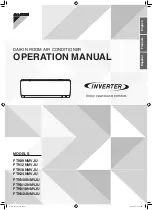
V6R VRF 50Hz
Part 3 - S
yst
em Design and Ins
talla
tion
Mini Amazon III Series
123
6 Insulation
6.1 Refrigerant Piping Insulation
6.1.1 Purpose
During operation, the temperature of the refrigerant piping varies. Insulation is required to ensure unit performance and
compressor lifespan. During cooling, the gas pipe temperature can be very low. Insulation prevents condensation forming on
the piping. During heating, the gas pipe temperature can rise to as high as 100°C. Insulation serves as necessary protection
from burns.
6.1.2 Selecting insulation materials
Refrigerant piping insulation should be closed-cell foam of B1 fire resistance rating that can withstand a constant
temperature of over 120°C and that complies with all applicable legislation.
6.1.3 Thickness of insulation
Carry out heat insulation treatment for the pipes at the gas and liquid sides respectively. Pipes on the liquid and air sides
have a low temperature during cooling. Take sufficient insulation measures to prevent condensation. Minimum
thicknesses for refrigerant piping insulation are specified in Table 3-6.1.
Table 3-6.1: Refrigerant piping insulation thickness
Pipe outer diameter
(mm)
Minimum insulation thickness
(mm)
Ф6.35
15
Ф9.53
Ф12.7
Ф15.9
20
Ф19.1
Ф22.2
Ф25.4
Ф28.6
6.1.4 Installation of piping insulation
With the exception of joint insulation, insulation should be applied to piping before fixing the piping in place. Insulation at
joints in refrigerant piping should be applied after the gas tightness test has been completed.
Notes for installers
Installation of insulation should be carried out in a manner suited to the type of insulation material being used.
Ensure there are no gaps at the joints between sections of insulation.
Do not apply tape too tightly as doing so may shrink insulation, reducing its insulating properties leading to
condensation and loss of efficiency.
Insulate gas and liquid pipes separately, otherwise heat exchange between the two sides will greatly impact
efficiency.
Do no
t bind the separately insulated gas and liquid pipes together too tightly as doing so can damage the joints
between sections of insulation.
6.1.5 Installation of joint insulation
Insulation at joints in the refrigerant piping should be installed after the gas tightness test has been successfully
completed. The procedure at each joint is as follows:
1. Cut a section of insulation 50 to 100mm longer than the gap to be filled. Ensure that the cross-sectional and
longitudinal openings are all cut evenly.
2. Embed the section into the gap ensuring that the ends abut tightly to the sections of insulation either side of the gap.
3. Glue the longitudinal cut and the joints with the sections of insulation either side of the gap.
4. Seal the seams with tape.
Содержание KMF-100 DVN4
Страница 140: ......
















































